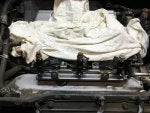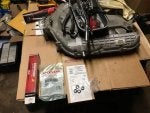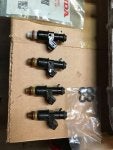Here is something you don't see much of any more in this forum. A troubleshooting guide for the engine misfire.
I recently got to work on 2007 Honda Odyssey EXL-R, VCM engine.
The owner had been chasing an engine misfire for some time. The story as relayed to me was, spark plugs were changed,
coil swap game was done, valves were adjusted, car continues to misfire, usually cold.
Rule #1, start from scratch, especially since I found a new (aftermarket) coil on cylinder #3 vs #6, it naturally crept in my head that perhaps the
previous techs did not know the order of cylinders.
I have the Helms Service manual, which is excellent and I highly recommend it for anybody doing work on their van.
Observing the van running, the misfire was almost impercetable, definitely not as bad as I expected.
Cylinder #6 is front row right most facing the engine, so its easy to access when engine cover is removed.
I disconnected the coil electrical connector and the misfire beat changed and became worse.
I have a decent code scanner Autel MD802, which was definitely very helpful in this case.
The troubleshooting procedure in Helms says:
1. swap coils - did that, and confirmed misfire stayed with #6.
2. swap plugs - did that, plugs were nice and clean, definitely newish, definitely oem, definitely good gap, again confirmed misfire stayed with #6.
Then I decided to stray off the beaten path and did compression test and leakdown test on cylinder #6. Both showed that there were no issues with the cylinder.
3. swap fuel injectors - now this is a new one on me, to swap injectors, you need to disassemble the intake plenum. Its not a huge job, but still takes time
to take things off, and then reassemble. I did not bother with new gaskets, and was able to confirm that throttle body, upper intake and lower intake gaskets were ok.
I also did not want to just install the new injector because plenty of part swapping was already done to no good effect.
Basic steps on removing plenum are:
Take the battery out, take out air box, remove air intake rubber boot, disconnect throttle body and slide it off the plenum, do not remove from the car, there are some hoses
under it that can stay put. Remove upper intake cover, bunch of small bolts around perimeter and two nuts. Disconnect couple of hoses and electrical connectors from the plenum.
Unbolt a bunch of bolts that were exposed by removing upper cover and two nuts. The plenum should slide up vertically on two rods.
This exposes the split intake manifolds and both fuel rails. Each fuel rail is fastened by two bolts and the fuel hose connector is a simple pinch and release type, no special tool
required. I wrapped it in a clean rug, in case the fuel decided to spray all over. (prior to the job, I pulled fuel pump fuse and cranked the car for a bit to relive fuel pressure, you can do either
fuse or relay). Each fuel injector is held in by a metal clip, that simply pulls out. Each injector has two o-rings, one that sits in the rail and one that goes into intake manifold.
So after getting the fuel rail out, I inspected the injectors. Nothing was obviously wrong with them, so I proceeded to swap #5 and #6.
I put the car together. Then started the car with my scanner connected and observing various misfire pids. Right away I saw that the misfire moved to cylinder #5 and #6 was
in clear. This was the positive diagnosis I was looking for. So it was definitely Fuel injector #6 that was causing an issue.
I bought a replacement part at Advance Auto parts and it was Intermotor brand box. Imagine my surprise when out of the box came Honda OEM packaged injector!
I went for aftermarket due to time crunch and not being able to source the part from Honda dealer on short notice. I was doing the work on Thanksgiving.
The new injector comes with brand new o-rings, so in addition that that, I bought a felpro pack of 4 injector rings to replace both sets of o-rings on the other two injectors.
I replaced the fuel injector with a new one and confirmed that misfires went away. Felt really good to chase this one down.
There might be better ways to test the injector without removing it out of the car, may require a scope or higher end Diagnostic tool.
I often read about engine misfires on these Honda Engines, and don't see a lot of resolutions. This should help a few people out.
picture of upper plenum with cover removed
![]()
upper plenum removed
![]()
fuel rail for cylinders 4, 5 and 6
![]()
new parts
![]()
injectors, the new one is the one that has white plastic, the bad one was marked with white paint
![]()
I recently got to work on 2007 Honda Odyssey EXL-R, VCM engine.
The owner had been chasing an engine misfire for some time. The story as relayed to me was, spark plugs were changed,
coil swap game was done, valves were adjusted, car continues to misfire, usually cold.
Rule #1, start from scratch, especially since I found a new (aftermarket) coil on cylinder #3 vs #6, it naturally crept in my head that perhaps the
previous techs did not know the order of cylinders.
I have the Helms Service manual, which is excellent and I highly recommend it for anybody doing work on their van.
Observing the van running, the misfire was almost impercetable, definitely not as bad as I expected.
Cylinder #6 is front row right most facing the engine, so its easy to access when engine cover is removed.
I disconnected the coil electrical connector and the misfire beat changed and became worse.
I have a decent code scanner Autel MD802, which was definitely very helpful in this case.
The troubleshooting procedure in Helms says:
1. swap coils - did that, and confirmed misfire stayed with #6.
2. swap plugs - did that, plugs were nice and clean, definitely newish, definitely oem, definitely good gap, again confirmed misfire stayed with #6.
Then I decided to stray off the beaten path and did compression test and leakdown test on cylinder #6. Both showed that there were no issues with the cylinder.
3. swap fuel injectors - now this is a new one on me, to swap injectors, you need to disassemble the intake plenum. Its not a huge job, but still takes time
to take things off, and then reassemble. I did not bother with new gaskets, and was able to confirm that throttle body, upper intake and lower intake gaskets were ok.
I also did not want to just install the new injector because plenty of part swapping was already done to no good effect.
Basic steps on removing plenum are:
Take the battery out, take out air box, remove air intake rubber boot, disconnect throttle body and slide it off the plenum, do not remove from the car, there are some hoses
under it that can stay put. Remove upper intake cover, bunch of small bolts around perimeter and two nuts. Disconnect couple of hoses and electrical connectors from the plenum.
Unbolt a bunch of bolts that were exposed by removing upper cover and two nuts. The plenum should slide up vertically on two rods.
This exposes the split intake manifolds and both fuel rails. Each fuel rail is fastened by two bolts and the fuel hose connector is a simple pinch and release type, no special tool
required. I wrapped it in a clean rug, in case the fuel decided to spray all over. (prior to the job, I pulled fuel pump fuse and cranked the car for a bit to relive fuel pressure, you can do either
fuse or relay). Each fuel injector is held in by a metal clip, that simply pulls out. Each injector has two o-rings, one that sits in the rail and one that goes into intake manifold.
So after getting the fuel rail out, I inspected the injectors. Nothing was obviously wrong with them, so I proceeded to swap #5 and #6.
I put the car together. Then started the car with my scanner connected and observing various misfire pids. Right away I saw that the misfire moved to cylinder #5 and #6 was
in clear. This was the positive diagnosis I was looking for. So it was definitely Fuel injector #6 that was causing an issue.
I bought a replacement part at Advance Auto parts and it was Intermotor brand box. Imagine my surprise when out of the box came Honda OEM packaged injector!
I went for aftermarket due to time crunch and not being able to source the part from Honda dealer on short notice. I was doing the work on Thanksgiving.
The new injector comes with brand new o-rings, so in addition that that, I bought a felpro pack of 4 injector rings to replace both sets of o-rings on the other two injectors.
I replaced the fuel injector with a new one and confirmed that misfires went away. Felt really good to chase this one down.
There might be better ways to test the injector without removing it out of the car, may require a scope or higher end Diagnostic tool.
I often read about engine misfires on these Honda Engines, and don't see a lot of resolutions. This should help a few people out.
picture of upper plenum with cover removed

upper plenum removed

fuel rail for cylinders 4, 5 and 6

new parts

injectors, the new one is the one that has white plastic, the bad one was marked with white paint





